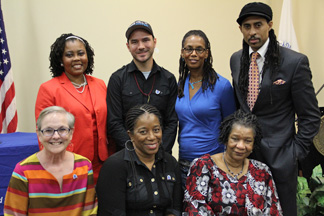News Releases from Region 04
EPA Celebrates Five Alabama Graduates of Inaugural Environmental Justice Academy
ATLANTA – During a ceremony Saturday at Kennesaw State University in Kennesaw, Ga., representatives from the U.S. Environmental Protection Agency (EPA) honored 21 graduates from the inaugural class of the Environmental Justice Academy, including five from Alabama. The EJ Academy is a rigorous, in depth leadership development program. EPA provided the 9-month environmental justice training program to cultivate skills participants can use to identify and address environmental challenges in their communities.
 Seated (l to r): Lella Lowe, Ruth Page-Nelson, Gilda Walker. Standing (l to r): EJ Academy Manager Sheryl Good, Ramsey Sprague, EPA Regional Environmental Justice and Sustainability Director Denise Tennessee, and Senior Advisor to the EPA Administrator Mustafa Ali.The five graduates from Alabama include:
Seated (l to r): Lella Lowe, Ruth Page-Nelson, Gilda Walker. Standing (l to r): EJ Academy Manager Sheryl Good, Ramsey Sprague, EPA Regional Environmental Justice and Sustainability Director Denise Tennessee, and Senior Advisor to the EPA Administrator Mustafa Ali.The five graduates from Alabama include:
- Lella B. Lowe of Mobile, AL, representing the Mobile Environmental Justice Action Coalition (MEJAC);
- Ramsey K. Sprague of Mobile, AL, representing the Mobile Environmental Justice Action Coalition (MEJAC);
- Kimberly M. Pettway of Mobile, AL, representing the Mobile Bay National Estuary Program;
- Ruth Page Nelson of Dothan, AL, representing Smart North America Inc./ Community Matters; and
- Gilda K. Walker of Fairfield, AL representing Belwood Action Committee
The EJ Academy launched in September 2015 and participants met monthly from Friday afternoon through Saturday. The EJ Academy is primarily based on EPA’s Collaborative Problem-Solving (CPS) Model, which is a seven-step process for bringing about positive change and community revitalization by having community leaders, community members, and their stakeholders working together. Each module focuses on one element of the CPS Model and includes a combination of lectures by subject-matter experts, in-class exercises, and homework assignments.
The EJ Academy taught participants:
- How to leverage human, social, intellectual, technical, legal, and financial resources to make long-term progress in a community;
- How to use consensus-building processes and skills to help ensure successful collaboration and negotiations;
- How to increase capacity to address communities’ environmental and/or public health issues; and
- A basic understanding of environmental justice and environmental regulations
As a result of participating in the EJ Academy, graduates received the following benefits:
- Complete a community portfolio, which will assist in securing funding, identifying partners, describing community resources and challenges and establishing credibility amongst stakeholders;
- Complete a plan that will guide organizational activities;
- Identify and secure potential partners to assist them with addressing their challenges;
- Interact directly with technical experts from EPA and other organizations;
- Network with other community leaders and establish mutually beneficial relationships;
- Be eligible to apply for 40 hours of technical assistance from the Community Planning Assistance Program at the conclusion of the Program; and
- Receive individualized feedback, guidance, and assistance from experts.
The next EJ Academy will be announced later in May. For more information, contact: R4_EJAcademy@epa.gov
Connect with EPA Region 4 on Facebook: www.facebook.com/eparegion4
And on Twitter: @EPASoutheast
###
